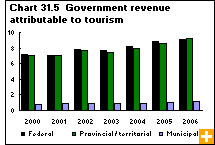Common menu bar links
Government revenues from tourism
Archived Content
Information identified as archived is provided for reference, research or recordkeeping purposes. It is not subject to the Government of Canada Web Standards and has not been altered or updated since it was archived. Please contact us to request a format other than those available.
Governments at all levels (federal, provincial/territorial and municipal) raise tax revenues from the various activities of tourists. For instance, when a tourist pays for a hotel room, this generates a federal goods and services tax, a provincial sales tax, and a room tax for the various levels of government. In addition, income taxes are collected from the earnings of hotel employees and from the profits of the business enterprise itself.
In 2006, the tourism sector generated $19.4 billion in revenue, up 29% from $15.0 billion in 2000. This increase stemmed partly from the air travellers security charge introduced in 2002, as well as increased tax revenues from tourist purchases, such as alcohol and tobacco, vehicle fuel, and camping equipment.
Another important source of government revenues from tourism was tax on products. More than half the tax revenue attributable to tourism in 2006—or $10.3 billion—was collected this way. Income taxes on the earnings of workers in the tourism sector generated another $4.5 billion, or close to one-quarter of the total tax revenue from tourism.
Combined, Canadian and international tourists spent $66.8 billion in Canada in 2006. For every dollar, Canada’s three levels of government collected 29.1 cents in 2006, up from 27.9 cents in 2000.
The federal government raised 13.6 cents, the provincial and territorial governments took in 13.9 cents, while municipal governments received 1.6 cents. Tourism accounted for 4% of government revenues in 2006—more than its 2% share of the gross domestic product.



